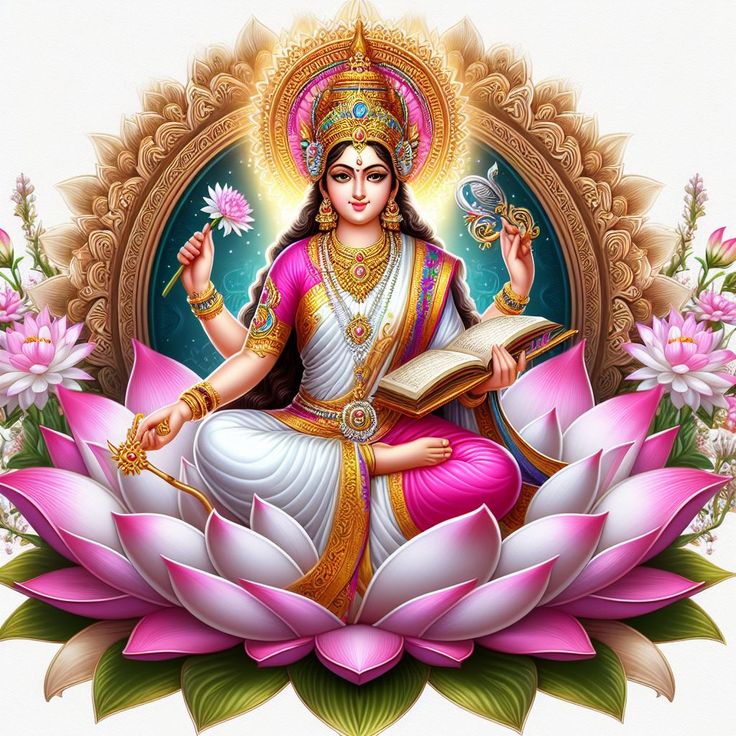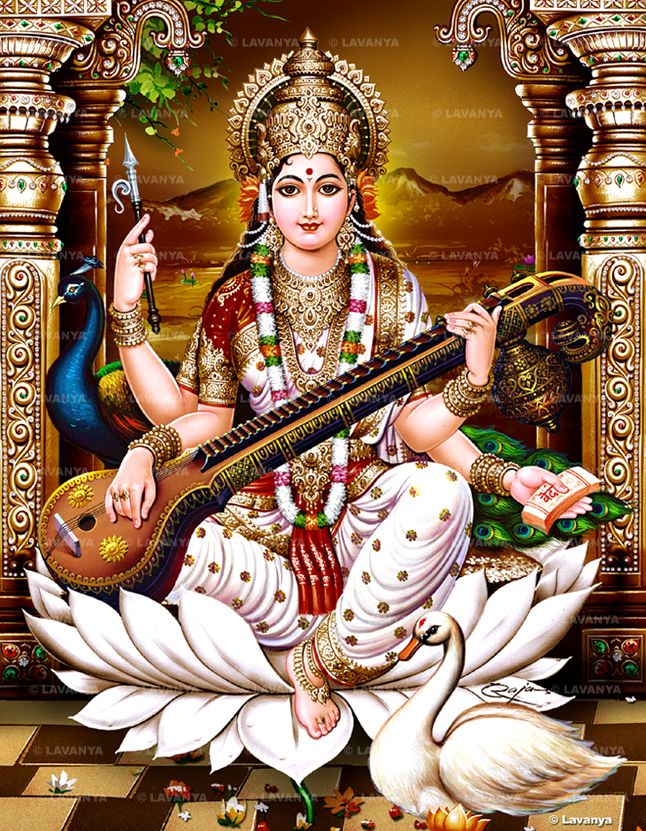Ma Saraswati : Saraswati’s Role in the Mahabharata
Introduction
For millennia, audiences have been enthralled by the ancient Indian epic Mahabharata, which weaves a tapestry of complex stories exploring the depths of human nature, divine intervention, and the ongoing conflict between righteousness and greed. Among this great narrative, the beloved Saraswati River takes the stage, its presence and importance weaved throughout the events of the epic. This page seeks to clarify the mythological, historical, and cultural relevance of the Saraswati River in the Mahabharata.
Saraswati within the Vedas and Puranas
With many references to its heavenly character and significance, the Saraswati River is rather important in the Vedic and Puranic writings. Mentioned no fewer than 72 times in the Rigveda, the Saraswati is significantly more often than any other well-known river. This profusion of sources emphasizes the respect and importance the Saraswati commands in the ancient writings. Moreover, one of the eighteen main Puranas in Hinduism, the Vamanapurana offers thorough historical narratives of the Saraswati River, therefore securing its position in the rich fabric of Indian mythology.

Saraswati’s function in the Mahabharata
Deeply entwined with the Saraswati River is the great war between the Pandavas and the Kauravas, the Mahabharata. Within the Shalya Parva of the Mahabharata, the Teerthayatra Parva is a fascinating account of Balarama’s journey along the banks of the Saraswati, therefore offering a lot of detailed information on the river and the sages living on its banks.
Kurukshetra: The Selected Battlefield
The Saraswati River’s impact on the choice of Kurukshetra as the epic battle venue defines one of the most important roles it performs in the Mahabharata. The committee assigned to create the Saraswati River curriculum for Haryana schools has advised that pupils should be taught about the river’s central importance in this sense. Kurukshetra was selected as the battlefield since it was on the banks of the Saraswati, a site judged lucky and important for the great struggle.

Balarama’s Pilgrimage and the Saraswati
Balarama’s trip along the Saraswati River is meticulously recorded in the Mahabharata’s Teerthayatra Parva. There is a wealth of descriptions in this part that might help one investigate a potential date for the Mahabharata events. Balarama’s trip across the Saraswati offers insightful analysis of the historical background of the epic since it vividly shows the river, the sages living on its banks, and the several holy locations visited.
Conflict between Vasishtha and Vishwamitra
With the Saraswati River central in this story, the Mahabharata also relates the fabled fight between the sages Vasishtha and Vishwamitra. Driven by his ambition to outshine Vasishtha’s spiritual ability, the epic tells how Vishwamitra tried to clean away Vasishtha’s ashram using the Saraswati River. But the river intervened to save Vasishtha, realizing the wrongness of Vishwamitra’s acts, therefore rendering the Saraswati cursed and turning it into a river of blood.

Finding the Saraswati River Rediscovery
Scholars and historians questioned the existence of the Saraswati River for a long period since it was regarded as a mythological creature. Recent developments in satellite imaging and archeological study, however, have exposed a clear paleochannel of the Saraswati River—which flowed across the deserts of Haryana, Rajasthan, and Gujarat before emptying into the ocean. This finding challenges the long-held Aryan Invasion/Migration Theory and offers convincing proof for the antiquity of Vedic civilization, therefore having broad ramifications.
Saraswati’s Haryana Initiative and Revitalization
Acknowledging the historical and cultural value of the Saraswati River, the Haryana government has acted aggressively to bring about preservation of its legacy. Under Chief Minister Manohar Lal Khattar, the Haryana Saraswati Heritage Development Board (HSHDB) has established a 14-member “Saraswati River Syllabus Committee” to include the river’s background and relevance into the course for pupils in classes 4 through 12. This project seeks to inform the younger generation on the function of the Saraswati River in the Mahabharata and its wider influence on Indian civilization.
Saraswati: Representing Continuity in Civilization
Our knowledge of Indian history and culture is much changed by the rediscovery of the Saraswati River and its prominence in the Mahabharata. Along with its descriptions in Vedic and Puranic scriptures, the river’s appearance in the epic emphasizes the great ongoing continuity of Indic civilization. This fresh awareness has sparked a rebirth of scholarly and public interest in the rich legacy of India by igniting a fresh enthusiasm in investigating the abundance of knowledge and insights contained inside these ancient books.

The Saraswati: Observant of Conflicts and Changes
The Saraswati River has great symbolic meaning because of how the Mahabharata presents it as a witness to the struggle between Vasishtha and Vishwamitra and later part in the Rakshasas transformation and emancipation. The river is a strong emblem of the interdependence of all things and the continuous search for righteousness and enlightenment since it can transcend the domains of mortal and divine and bring about redemption and illumination.
Saraswati: a mukti giver
The Saraswati River is called “Guptagamini,” or the one who flows in a secret, in the Mahabharata. The finding of the river’s physical paleochannel has suddenly changed its subdued presence in people’s consciousness. Hindu beliefs hold that the Ganga flowed over the ashes of Bhagiratha’s ancestors to grant Mukti (liberation), so freeing the minds of modern Indians and renewing their confidence in their civilizational legacy and encouraging a closer study of the wisdom contained within their ancient texts.
The Saraswati: Notes on the Great Conflict
The Saraswati River gains enormous importance from the Mahabharata’s portrayal as a witness to the great fight between the Pandavas and the Kauravas as well as from its choice as the battlefield. The river’s significance as a holy and beloved entity in the Hindu religion is underlined by its location at the site of this great war that defined the path of Indian history.

Saraswati: a Transformational Harbinger
Through the intervention of the sages, the Mahabharata’s story of the Saraswati River’s metamorphosis from a river of blood to a purifier of the Rakshasas is a potent metaphor for the river’s capacity to enable spiritual and social change. Through the power of dedication, austerity, and divine grace, this narrative emphasizes the river’s function as a means of redemption for people who have wandered from the road of righteousness, so signifying the possibility of both personal and group transformation.
Saraswati: Coordinator of Civilizational Thought
Indic civilizational theory might find unity in the prominence of the Saraswati River in the Mahabharata and its rediscovery in the modern period. Along with its descriptions in Vedic and Puranic scriptures, the river’s appearance in the epic emphasizes the great ongoing continuity of Indian culture and legacy. This increased awareness has the ability to inspire among the people of India a fresh respect of the abundance of knowledge and ideas included inside these old books, so promoting pride and belonging.
Conclusion
The great relevance of the Saraswati River in the complex fabric of Indian mythology and history is shown by its central part in the Mahabharata. From its existence in the Vedas and Puranas to its impact on the events of the epic and the choice of the Kurukshetra battlefield, the Saraswati becomes a significant character, therefore reflecting the interdependence of the divine and mortal domains. The finding of the physical reality of the river has had far-reaching consequences, questioning accepted wisdom and motivating further study of the knowledge found in India’s historic writings. The Saraswati River never fails to enthrall and inspire as we explore the Mahabharata’s stories, so attesting to the continuing vitality of Indic civilization.
#Mahabharata #saraswati #puja #saraswati #pujasaraswati







